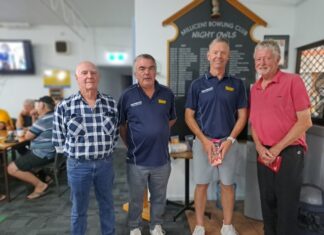By Graham Greenwood
WHEN my parents decided to immigrate to Australia in 1952 there were certain strings attached to gaining entry into their new country.
One of the criteria was that my father Norm required guaranteed employment upon arrival and while we stayed with a “nominated” family in Alberton initially, within six months we were required to buy or rent our own home.
Because Norm was a returned soldier he received help from the Repatriation Department in finding employment with the Austin Motor Company, working in spare parts.
After six months my parents bought a half-built weatherboard home in Ethelton, the “Bronx” of Port Adelaide.
Like many other migrants before and after us, my parents were hard-workers and quickly became “Aussies”.
In 1954 we moved to Mount Gambier where Norm took a job as spare parts manager at local Austin dealership, Walkers Garage.
Some years later, my mother Gladys worked on the hospital catering staff, working with many other migrants and made life-long friendships with people such as Luisa Dellorefice who died last month.
It was then I first learnt of the amazing work ethic of the Italian, Polish, German and Dutch migrants and what they did for the timber industry and local economy.
These migrants came to Australia looking for a better life after leaving war-torn Europe with nothing more than hope, a few possessions and in some cases arriving with only the clothes they were wearing.
Many were forced to work in the forest and timber mills, and history has recorded that without their dedicated efforts the industry would not be where it is today.
What was different then was that there was no safety net, no welfare payments, no free health benefits, no subsidised housing.
Migrants of the 1950s and 60s took on manual labor jobs because it was the only way to earn a living.
While migrants are still important to increasing population, the lure of so many welfare opportunities becomes counter-productive in encouraging these people to find jobs.
Recently the Limestone Coast Local Government Association (LCLGA) put forward an economic growth blueprint for the South East which basically claims an opportunity to create 5700 jobs and boost the economy annually by $700m by 2026.
I have heard these type of claims many, many times during the past 50 years and mostly nothing ever comes of it.
In the past they have included promises of economic growth, more jobs, new rail links to both Adelaide and Melbourne, export growth opportunities, with tourism and hospitality to be the saviour of the state and the South East.
Premier Don Dunstan went closest to making it happen with his decentralisation plan which did boost the local economy for a while, then there was the Green Triangle agreement which increased trade between the South East and Western District of Victoria – both came and went without much of a whimper.
Then government told us hospitality, then tourism, then the wine industry would pull the state out of its economic mess – the jury is still out and the state is still broke.
Part of the LCLGA blueprint is to boost population growth through migrants, therefore creating the need for more jobs.
It’s like, which comes first, the chicken or the egg.
Reportedly the LCLGA will announce its priority job opportunities soon but the problem is getting migrants to go to the regional areas where the demand is.
One bright hope is growth of the timber industry where in recent weeks Timberlink has announced expansion plans worth $90m and One-Forty-One will spend more than $20m on their city mill.
How much of that is technology and how much will produce on-the-ground jobs is unknown.
The dilemma remains getting migrants to move to the country and that is something the Federal Government is seriously looking at.
The government’s push is also to get more migrants with trade skills to regional areas and if this were to be successful today’s migrants would become trailblazers as those in the past in making a big contribution to the regional economy.
Let’s hope the LCLGA plan works but declaring it will happen by 2026 may be a little optimistic.





